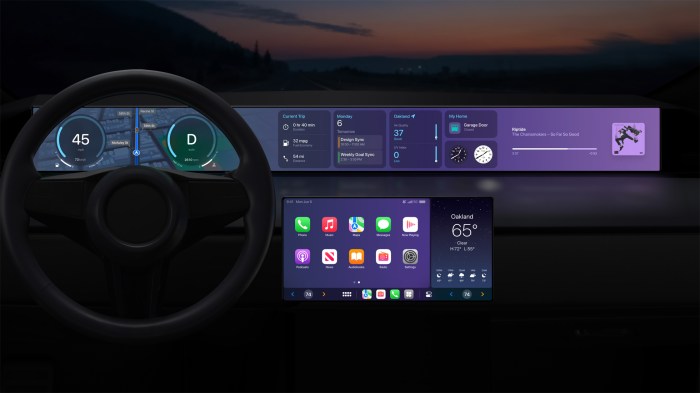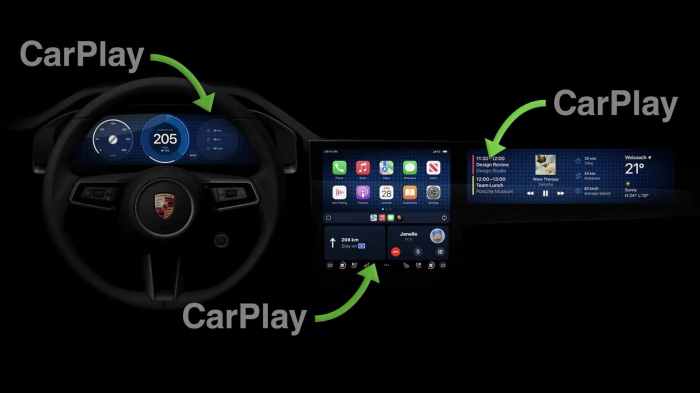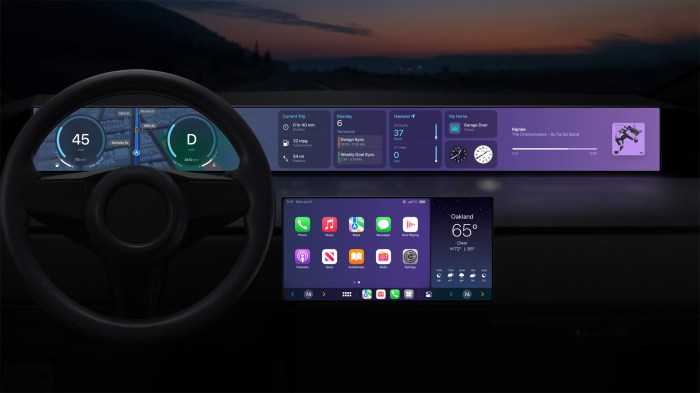
Apple Next-Gen CarPlay: Whats New and Why It Matters
Apple next gen carplay – Apple Next-Gen CarPlay is poised to revolutionize the way we interact with our vehicles. Beyond just playing music and making calls, the next generation of CarPlay promises a seamless integration of our iPhones with our cars, transforming the driving experience into something more intuitive, personalized, and connected.
This update is more than just a cosmetic upgrade; it’s a fundamental shift in how we think about in-car technology. Apple is pushing the boundaries of what’s possible, integrating features like multi-window displays, advanced widgets, and deeper vehicle system integration.
This means a future where CarPlay isn’t just a secondary interface, but a core component of the car itself.
Apple CarPlay Evolution
Apple CarPlay has revolutionized the way we interact with our cars, seamlessly integrating our iPhones with our vehicles’ infotainment systems. Since its inception, CarPlay has undergone significant evolution, bringing about numerous improvements and advancements.
History and Key Features
Apple CarPlay was first introduced in 2014 as a way to provide a safer and more intuitive way to use iPhone features while driving. It allowed users to access their favorite apps, make calls, send messages, and listen to music through their car’s display and controls.
CarPlay’s initial features included:
- Phone Calls:Users could make and receive calls using Siri or the car’s controls.
- Messaging:Send and receive messages through Siri or by using the car’s display.
- Music Playback:Access music libraries from Apple Music, Spotify, and other streaming services.
- Navigation:Use Apple Maps for turn-by-turn navigation.
- Third-Party Apps:Access a range of apps including podcasts, audiobooks, and weather apps.
Current State and Limitations
Today, CarPlay is a widely adopted feature in many modern vehicles. It offers a wide range of functionalities and has become an essential part of the connected car experience. However, CarPlay still has some limitations:
- Limited Customization:While CarPlay offers a user-friendly interface, it lacks the level of customization available on a smartphone.
- Dependency on iPhone:CarPlay relies heavily on the iPhone, requiring users to have an iPhone to use it. This can be a barrier for Android users.
- Compatibility Issues:Not all car models are compatible with CarPlay, and some older vehicles may require software updates to support it.
- Limited Functionality:Certain features, such as climate control and seat adjustments, are not directly accessible through CarPlay.
Recent Advancements and Innovations
Apple has continuously updated CarPlay with new features and improvements. Recent updates have brought significant advancements:
- Wireless CarPlay:The introduction of wireless CarPlay has eliminated the need for a physical connection between the iPhone and the car, making it even more convenient.
- Improved Interface:CarPlay’s interface has been refined with a more modern and intuitive design, offering a more seamless user experience.
- Enhanced Siri Integration:Siri’s capabilities have been expanded in CarPlay, allowing users to control more functions and apps using voice commands.
- New App Support:CarPlay now supports a wider range of apps, including third-party navigation apps, parking apps, and more.
- Multi-Window Support:The latest version of CarPlay allows users to view multiple apps simultaneously, providing a more versatile and efficient experience.
Next-Gen CarPlay Features and Capabilities
Apple’s next-generation CarPlay promises a significant leap forward in the in-car experience, offering a more immersive, personalized, and feature-rich interface. Rumors and leaks suggest that the new CarPlay will be more deeply integrated with vehicle systems, offering drivers a wider range of functionalities and enhanced control over their vehicles.
Apple’s next-gen CarPlay is shaping up to be a game-changer for in-car experiences, and it’s great to see Apple focusing on improving their other products too. For example, they’ve just addressed a major issue with the Vision Pro in the VisionOS 11 beta, allowing users to reset their passwords without needing to visit an Apple store.
This kind of attention to detail across their product line is a positive sign for the future of CarPlay and the overall Apple ecosystem.
Interface and Functionality
The new CarPlay is expected to have a redesigned interface that takes advantage of the larger displays found in modern vehicles. This could include a more intuitive layout, with larger icons, improved readability, and more customizable widgets. Apple may introduce a new “multi-window” feature, allowing drivers to view multiple apps simultaneously.
Apple’s next-gen CarPlay is shaping up to be a game-changer, offering a more integrated and personalized experience behind the wheel. But with all the new features and apps, it’s even more important to keep track of your spending. Luckily, there are some amazing best expense tracker apps available to help you manage your budget, so you can enjoy all the benefits of CarPlay without breaking the bank.
Whether you’re planning a road trip or just commuting to work, staying on top of your finances will help you make the most of your driving experience.
The new CarPlay might also offer improved voice control, with enhanced natural language processing for more accurate and nuanced interactions.
Integration with Vehicle Systems
Next-gen CarPlay is rumored to offer deeper integration with vehicle systems, extending its functionality beyond the traditional infotainment system. Drivers could potentially control climate settings, seat adjustments, and even vehicle functions like parking assist and driver assistance features directly through CarPlay.
Apple’s next-gen CarPlay is shaping up to be a game-changer for in-car experiences, promising a more integrated and personalized driving environment. But while Apple’s engineers are busy crafting this seamless interface, someone else is quietly working behind the scenes, ensuring the smooth flow of data that powers it all – the Database Administrator (DBA).
If you’re curious about what a DBA does all day, this article provides a fascinating glimpse into their world. From managing data security to optimizing performance, DBAs are the unsung heroes of the tech world, making sure our apps and services, including CarPlay, run flawlessly.
This integration could also allow for a more personalized driving experience, with CarPlay adapting to individual preferences and driving habits.
Comparison with Existing Features
The next-gen CarPlay will offer significant improvements over the current version. While the existing CarPlay provides access to a wide range of apps and features, it is limited in its integration with the vehicle. The new CarPlay is expected to overcome these limitations, offering a more seamless and integrated in-car experience.
Impact of Next-Gen CarPlay, Apple next gen carplay
The next-gen CarPlay is poised to revolutionize the in-car experience, impacting user experience, vehicle safety, and infotainment systems in several ways.
| Area | Impact |
|---|---|
| User Experience | The next-gen CarPlay will offer a more intuitive and personalized experience, with a redesigned interface, enhanced functionality, and deeper integration with vehicle systems. Drivers will enjoy a more seamless and engaging in-car experience. |
| Vehicle Safety | Next-gen CarPlay could enhance safety by offering features like driver monitoring and fatigue detection, potentially reducing accidents. The improved voice control and hands-free functionality could also minimize distractions while driving. |
| Infotainment Systems | Next-gen CarPlay will likely replace traditional infotainment systems, offering a more modern and feature-rich platform. This could lead to increased demand for connected cars and a more integrated in-car experience. |
Impact on the Automotive Industry

Next-gen CarPlay, with its deeper integration and enhanced capabilities, has the potential to significantly impact the automotive industry, influencing vehicle design, software development, and the overall user experience. This evolution is not just about adding features; it’s about redefining the relationship between drivers, cars, and the digital world.
Impact on Vehicle Design
The deeper integration of CarPlay means that the car’s design will need to accommodate the new features and capabilities. This includes:
- Larger, more interactive displays:Next-gen CarPlay will require larger, higher-resolution displays to accommodate the expanded interface and richer content. This will influence the design of the dashboard and center console, potentially pushing traditional gauges and buttons aside.
- Improved connectivity and hardware:To support the advanced features of next-gen CarPlay, vehicles will need more robust connectivity and hardware, including faster processors, more memory, and advanced sensors. This will necessitate a more sophisticated electrical architecture and potentially influence the placement of antennas and other components.
- Enhanced voice control:With voice control becoming increasingly central to CarPlay, car manufacturers will need to incorporate advanced microphones and noise cancellation technologies to ensure clear and reliable voice commands. This could influence the design of the cabin and the placement of microphones.
User Experience and Adoption
Next-gen CarPlay promises a significant leap forward in the way drivers and passengers interact with their vehicles. Its redesigned interface and enhanced features aim to create a more intuitive and engaging experience, potentially leading to wider adoption.
User Interface Design
The user interface of next-gen CarPlay is expected to be a major departure from its predecessor. The interface will be more visually appealing and intuitive, featuring a larger, customizable home screen that can display multiple widgets and apps simultaneously. This approach allows for greater personalization and quicker access to frequently used functions.
For instance, drivers can customize their home screen with widgets for navigation, music, and phone calls, ensuring easy access to these essential features.
Potential Benefits for Drivers and Passengers
Next-gen CarPlay offers a range of potential benefits for both drivers and passengers. The enhanced user interface provides a more intuitive and user-friendly experience, leading to less distraction and increased safety. The seamless integration with smartphones allows for access to a wider range of apps and services, enriching the driving experience.
- Improved Safety:The intuitive interface and reduced distraction contribute to a safer driving experience. Drivers can access vital information and control functions without taking their eyes off the road for extended periods. For example, a glance at the screen can quickly show directions, incoming calls, or the current music track, minimizing the need for prolonged interaction.
- Enhanced Entertainment:Passengers can enjoy a wide range of entertainment options, including music streaming, podcasts, and video content. The seamless integration with smartphone apps provides access to a vast library of entertainment choices, making long journeys more enjoyable.
- Increased Convenience:The integration of CarPlay with various smartphone apps extends the convenience of mobile devices to the vehicle. Drivers can easily manage calls, send messages, and use navigation apps without the need for physical interaction with their phones.
Challenges of Using Next-Gen CarPlay
While next-gen CarPlay offers many advantages, it also presents some potential challenges:
- Compatibility Issues:The adoption of next-gen CarPlay depends on the compatibility of vehicles with the new system. Older vehicles may require software updates or hardware modifications to support the new features, potentially posing a challenge for some car owners.
- Data Usage:The use of various apps and features can lead to increased data consumption, which can be a concern for drivers with limited data plans.
- Security Concerns:As with any connected technology, there are security concerns associated with CarPlay. The system relies on a secure connection to the smartphone, and any vulnerabilities could potentially compromise the vehicle’s data and security.
Factors Influencing Adoption Rate
The adoption rate of next-gen CarPlay will be influenced by various factors:
- Vehicle Compatibility:The availability of next-gen CarPlay in newer vehicles will play a significant role in its adoption. As more car manufacturers integrate the system into their models, its accessibility will increase, leading to wider adoption.
- Consumer Awareness:Raising awareness about the features and benefits of next-gen CarPlay is crucial for driving adoption. Marketing campaigns and user reviews can help educate consumers about the advantages of the system.
- Price and Cost:The cost of upgrading existing vehicles to support next-gen CarPlay could be a barrier for some consumers. The affordability of the system will be a key factor in its widespread adoption.
Competition and Future Directions: Apple Next Gen Carplay

Next-gen CarPlay faces stiff competition from other infotainment systems and technologies. While Apple’s platform boasts a strong user base and intuitive interface, rivals are constantly innovating, pushing the boundaries of what’s possible in the automotive space.
Comparison with Competing Infotainment Systems
The automotive industry is a diverse landscape, with numerous players vying for dominance in the infotainment sector. Here’s a comparison of next-gen CarPlay with some of its key competitors:
- Android Automotive OS:Google’s Android Automotive OS is a direct competitor to CarPlay, offering a highly customizable and feature-rich experience. Android Automotive is integrated directly into the vehicle’s operating system, providing a more seamless experience and access to a wider range of apps.
However, it is not as widely available as CarPlay and may lack some of the intuitive user interface elements that CarPlay offers.
- Tesla’s Infotainment System:Tesla’s infotainment system is known for its large touchscreen interface and advanced features, including over-the-air updates and a suite of driver assistance technologies. However, it is a closed system, limiting user customization and app access. Tesla’s system also has a steep learning curve for new users.
- Luxury Car OEM Systems:High-end car manufacturers like Mercedes-Benz, BMW, and Audi often develop their own proprietary infotainment systems. These systems are typically highly integrated with the vehicle’s functions and offer a premium user experience. However, they can be expensive and may not be as widely compatible with third-party apps as CarPlay.
Potential for Future Advancements in CarPlay
CarPlay has a bright future, driven by continuous innovation and the evolving automotive landscape. The platform is poised to play a central role in the connected car revolution, with advancements in areas like:
- Augmented Reality:Next-gen CarPlay could leverage augmented reality (AR) to overlay digital information onto the real world. Imagine navigation directions projected onto the windshield, or real-time traffic updates superimposed on the road ahead. This technology would enhance driver safety and convenience by providing crucial information without distracting the driver from the road.
- Artificial Intelligence:AI can revolutionize the CarPlay experience. AI-powered voice assistants could become more intuitive and personalized, anticipating user needs and offering proactive assistance. AI could also be used to optimize navigation routes, personalize music recommendations, and even adjust vehicle settings based on driver preferences.
- Connected Car Ecosystems:CarPlay is likely to integrate seamlessly with connected car ecosystems. This would enable drivers to remotely control vehicle functions, receive real-time vehicle diagnostics, and access a wider range of services through their CarPlay interface.


